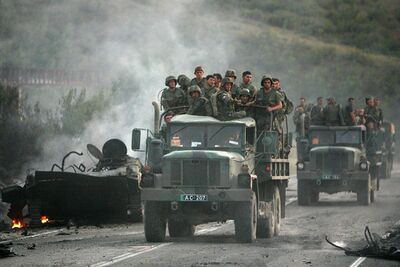Battle of Balatonalmádi
The Battle of Balatonalmádi was a battle fought from 16 - 23 September 2008 during the Zemplen War, between the Syaran Commonality Armed Forces against the defending Imperial Armed Forces of Ruvelka. The primary participants were the 6th Army under Colonel General Zlaten Danielov Velikov against a combination of Ruvelkan Imperial Army units and the Ruvelkan Territorial Defense Forces under the command of General Eliska Hanáková. The battle occurred during Operation Aspis, the initial Syaran invasion intended to destroy the Ruvelkan military and force the Principality to sue for peace. Although outnumbered 2:1, the still mobilizing Ruvelkan forces were caught unprepared for the offensive and were ill prepared for high intensity combat operations.
The city of Balatonalmádi had served as a rally point for mobilized and recently raised Ruvelkan military forces and reserves during the summer fighting in 2008. Located just 65 kilometers from the border with Syara, Balatonalmádi was strategically difficult to defend for the Ruvelkans. During the August Offensive the city's rail station had been bombed twice by the Commonality Air Force, but had otherwise been uninvolved in the fighting thus far. General Eliska Hanáková, who had been appointed commander of Ruvelkan military forces in the central part of the border, had been using the city's transportation hub as a staging ground for local Imperial Army and Territorial Defense Forces, intending to eventually compose a force to recapture some of the disputed border region. By mid-September this amounted to over 300,000 troops, but many were Ruvelkan troops were still in the process of taking armaments out of storage and distributing supplies, rendering the force under-equipped. On 16 September four Syaran divisions, who had crossed the border two days earlier, assaulted Ruvelkan positions south of the city, severing the rail line with Dunakesi further south. Pitched fighting broke out as the Ruvelkans attempted to hold back the Syaran assault, while simultaneously evacuating the city of most of its inhabitants. On 20 September the Syarans struck north of the city, achieving a breakthrough with the 52nd Mechanized Infantry Division under Major General Yorgos Gorceski. The breakthrough threatened to cut off the primary eastern highway out of the city and collapse the Ruvelkan lines. In response Hanáková committed the 5th Cavalry Division, the best armed and equipped formation in the Ruvelkan Army at that point, to block the advance of the 52nd Mechanized Division and the rest of the Syaran IX Corps. The 5th Cavalry Division bought time for the bulk of Ruvelkan troops to evacuate further east, but the 5th Cavalry was annihilated as a result and the city fell to the Syarans on 23 September.
The battle served to illustrate Ruvelkan difficulties with coordinating large formations during the early months of the war and is often cited as an example of the superior organizational skills that the Syarans initially enjoyed. The sacrifice of the 5th Cavalry Division by General Hanáková became an instantly controversial decision and nearly resulted in Hanáková being relieved of command, but Chief of the Imperial General Staff Áron Surány ultimately dismissed such notions. Post-war analysis is generally more forgiving towards Hanáková's decision to sacrifice the 5th Cavalry, citing it as an example of a difficult but ultimately correct decision made with strategic considerations in mind. While the 5th Cavalry was destroyed, over 260,000 Ruvelkan troops were able to escape encirclement, and later proved critical in halting Syaran drives further eastward.
